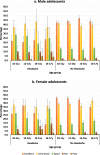The prevalence and burden of recurrent headache in Australian adolescents: findings from the longitudinal study of Australian children
- PMID: 34074243
- PMCID: PMC8170988
- DOI: 10.1186/s10194-021-01262-2
The prevalence and burden of recurrent headache in Australian adolescents: findings from the longitudinal study of Australian children
Abstract
Background: Headache disorders are highly prevalent worldwide, but not well investigated in adolescents. Few studies have included representative nationwide samples. This study aimed to present the prevalence and burden of recurrent headache in Australian adolescents.
Methods: The prevalence of recurrent headache, headache characteristics (severity and frequency) and burden on health-related quality of life in Australian children aged 10-17 years were presented, using nationally representative data from the Longitudinal Study of Australian children (LSAC). The LSAC, commencing in 2004, collects data every 2 years from a sample of Australian children of two different age cohorts: B 'baby' cohort, aged 0-1 years and K 'kindergarten' cohort, aged 4-5 years at the commencement of the study. Face-to-face interviews and self-complete questionnaires have been conducted with the study child and parents of the study child (carer-reported data) at each data collection wave, with seven waves of data available at the time of the current study. Wave 7 of the LSAC was conducted in 2016, with B cohort children aged 12-13 years and K cohort children aged 16-17 years. For the current study, data were accessed for four out of seven waves of available data (Wave 4-7) and presented cross-sectionally for the two cohorts of Australian children, for the included age groups (10-11 years, 12-13 years, 14-15 years and 16-17 years). All available carer-reported questionnaire data pertaining to headache prevalence, severity and frequency, general health and health-related quality of life, for the two cohorts, were included in the study, and presented for male and female adolescents. Carer-reported general health status of the study child and health-related quality of life scores, using the parent proxy-report of the Paediatric Quality of Life Inventory™ 4.0, were compared for male and female adolescents with recurrent headache and compared with a healthy group. Finally, health-related quality of life scores were compared based on headache frequency and severity.
Results: The LSAC study initially recruited 10,090 Australian children (B cohort n = 5107, K cohort n = 4983), and 64.1% of the initial sample responded at wave 7. Attrition rates across the included waves ranged from 26.3% to 33.8% (wave 6 and 7) for the B cohort, and 16.3% to 38.0% (wave 4-7) for the K cohort. Recurrent headache was more common in females, increasing from 6.6% in 10-11 years old females to 13.2% in 16-17 years old females. The prevalence of headache in males ranged from 4.3% to 6.4% across the age groups. Health-related quality of life scores were lower for all functional domains in adolescents with recurrent headache, for both sexes. Headache frequency, but not severity, was significantly associated with lower health-related quality of life scores, in both males and females.
Conclusions: Recurrent headache was common among Australian adolescents and increased in prevalence for females, across the age groups. Frequent recurrent headache is burdensome for both male and female adolescents. This study provides information regarding the prevalence and burden of recurrent headache in the adolescent population based on findings from the Longitudinal Study of Australian Children.
Keywords: Adolescents; Health-related quality of life; Longitudinal study of Australian children; Prevalence; Recurrent headache.
Conflict of interest statement
The authors declare that they have no competing interests.
Figures

References
-
- Vos T, Flaxman AD, Naghavi M, Lozano R, Michaud C, Ezzati M, et al. Years lived with disability (YLDs) for 1160 sequelae of 289 diseases and injuries 1990–2010: a systematic analysis for the global burden of disease study 2010. Lancet. 2012;380(9859):2163–2196. doi: 10.1016/S0140-6736(12)61729-2. - DOI - PMC - PubMed
-
- Vos T, Abate KH, Abbafati C, Abbas KM, Abd-Allah F, Abdulkader RS, et al. Global, regional, and national incidence, prevalence, and years lived with disability for 328 diseases and injuries for 195 countries, 1990–2016: a systematic analysis for the global burden of disease study 2016. Lancet. 2017;390(10100):1211–1259. doi: 10.1016/S0140-6736(17)32154-2. - DOI - PMC - PubMed
-
- Linde M, Gustavsson A, Stovner LJ, Steiner TJ, Barré J, Katsarava Z, Lainez JM, Lampl C, Lantéri-Minet M, Rastenyte D, Ruiz de la Torre E, Tassorelli C, Andrée C. The cost of headache disorders in Europe: the Eurolight project. Eur J Neurol. 2012;19(5):703–711. doi: 10.1111/j.1468-1331.2011.03612.x. - DOI - PubMed
MeSH terms
LinkOut - more resources
Full Text Sources
Medical

